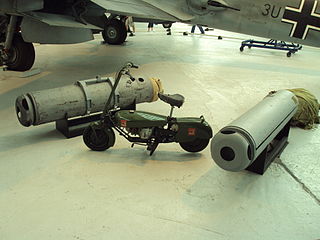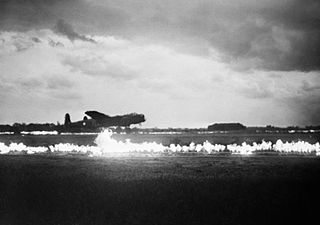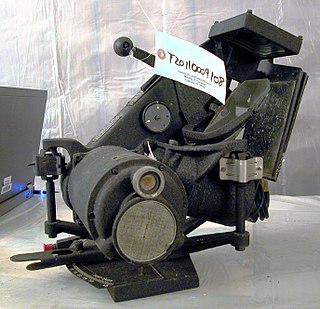 W
W1937 Pattern Web Equipment was an item of military load-carrying equipment. It replaced the 1908 Pattern and 1925 Pattern—on which it was based—and was standard issue for British and Commonwealth troops from its introduction in 1937, throughout World War II, and in the post-war period until it was superseded by 58 pattern webbing.
 W
WThe bombe is an electro-mechanical device used by the British cryptologists to help decipher German Enigma-machine-encrypted secret messages during World War II. The US Navy and US Army later produced their own machines to the same functional specification, albeit engineered differently both from each other and from Polish and British bombes.
 W
WThe Canal Defence Light (CDL) was a British "secret weapon" of the Second World War, based upon the use of a powerful carbon-arc searchlight mounted on a tank. It was intended to be used during night-time attacks, when the light would allow enemy positions to be targeted. A secondary use of the light would be to dazzle and disorient enemy troops, making it harder for them to return fire accurately. The name Canal Defence Light was used to conceal the device's true purpose. For the same reason, in US service they were designated T10 Shop Tractor.
 W
WThe Chariot was a British manned torpedo used in World War II. The Chariot was inspired by the operations of Italian naval commandos, in particular the raid on 19 December 1941 by members of the Decima Flottiglia MAS who rode "Maiali" human torpedoes into the port of Alexandria and there placed limpet mines on or near the battleships HMS Valiant and HMS Queen Elizabeth as well as an 8,000-ton tanker, causing serious damage which put both battleships out of operational use until 1943.
 W
WThe CLE Canister, or CLE Container was a standardized cylindrical container used by the British during World War 2 to airdrop supplies to troops on the ground. The name initially derived from the Central Landing Establishment that developed them, although this was later backronymed to Container Light Equipment.
 W
WCultivator No. 6 was the code name of a military trench-digging machine developed by the British Royal Navy at the beginning of World War II. The machine was originally known as White Rabbit Number Six; this code name was never officially recognised, but it was said to be derived from Churchill’s metaphorical ability to pull ideas out of a hat. The codename was changed to the less suggestive Cultivator Number Six to conceal its identity. The name was later changed to N.L.E. Tractors. Winston Churchill sometimes referred to the machine as his mole and the prototype machine was dubbed Nellie. It was lightly armoured and carried no weapons. It was designed to advance upon an enemy position largely below ground level in a trench that it was itself excavating. On reaching the enemy's front line, it would serve as a ramp for the troops and possibly tanks following in its trench.
 W
WThe F24 camera is a 1920s British camera used for aerial reconnaissance by British and Allied armed forces into the mid-1950s. It is widely and erroneously referred to as F.24 or F-24.
 W
WThe Fairbairn–Sykes fighting knife is a double-edged fighting knife resembling a dagger or poignard with a foil grip developed by William Ewart Fairbairn and Eric Anthony Sykes in Shanghai based on ideas which the two men had before World War II while serving on the Shanghai Municipal Police in China.
 W
WThe flimsy, officially known as the Petrol, Oil and Water can, was a World War II fuel container used by the British Army. They held 4 imperial gallons of fuel, which allowed them to be moved by a single person.
 W
WFog Investigation and Dispersal Operation (FIDO) was a system used for dispersing fog and pea soup fog from an airfield so that aircraft could land safely. The device was developed by Arthur Hartley for British RAF bomber stations, allowing the landing of aircraft returning from raids over Germany in poor visibility by burning fuel in rows on either side of the runway.
 W
WHeath Robinson was a machine used by British codebreakers at the Government Code and Cypher School (GC&CS) at Bletchley Park during World War II in Cryptanalysis of the Lorenz cipher. This achieved the decryption of messages in the German teleprinter cipher produced by the Lorenz SZ40/42 in-line cipher machine. Both the cipher and the machines were called "Tunny" by the codebreakers, who named different German teleprinter ciphers after fish. It was mainly an electro-mechanical machine, containing no more than a couple of dozen valves, and was the predecessor to the electronic Colossus computer. It was dubbed "Heath Robinson" by the Wrens who operated it, after cartoonist William Heath Robinson, who drew immensely complicated mechanical devices for simple tasks, similar to Rube Goldberg in the USA.
 W
WThe Helmet Steel Airborne Troops (HSAT) is a paratrooper helmet of British origin worn by paratroopers and members of airlanding units. It was introduced in Second World War by the British Army and was also used by other Commonwealth armies. It continued to be used in the post-war era – until the Falklands War, in the case of British airborne troops. As with the similarly shaped RAC helmet, it was initially manufactured by Briggs Motor Bodies at Dagenham.
 W
WConstructed using light steel nets, indicator nets were often anchored at various depths to the sea bed around Allied naval bases during both world wars. They were intended to entangle U-boat traffic of the enemy, even though the submarines often managed to disentangle themselves and escape before being blown up by depth charges.
 W
WThe Leigh Light (L/L) was a British World War II era anti-submarine device used in the Battle of the Atlantic. It was a powerful carbon arc searchlight of 24 inches (610 mm) diameter fitted to a number of the British Royal Air Force's Coastal Command patrol bombers to help them spot surfaced German U-boats at night.
 W
WThe Low Level Bombsight, Mark III, sometimes known as the Angular Velocity Sight, was a Royal Air Force (RAF) bombsight designed for attacks by aircraft flying below 1,000 feet (300 m) altitude. It combined components of the Mark XIV bomb sight with a new mechanical computer. It featured a unique solution for timing the drop, projecting a moving display onto a reflector sight that matched the apparent motion of the target at the right instant.
 W
WThe Mark XIV Bomb Sight was a bombsight developed by Royal Air Force (RAF) Bomber Command during the Second World War. It was also known as the Blackett sight after its primary inventor, P. M. S. Blackett. Production of a slightly modified version was also undertaken in the United States as the Sperry T-1, which was interchangeable with the UK-built version. It was the RAF's standard bombsight for the second half of the war.
 W
WThe British Middle East Command Camouflage Directorate organised major deception operations for Middle East Command in the Western Desert Campaign of the Second World War. It provided camouflage during the Siege of Tobruk; a dummy railhead at Misheifa, and the largest of all, Operation Bertram, the army-scale deception for the decisive battle of El Alamein in October 1942. The successful deception was praised publicly by Winston Churchill.
 W
WThe Mk III Helmet was a steel military combat helmet first developed for the British Army in 1941 by the Medical Research Council. First worn in combat by British and Canadian troops on D-Day, the Mk III and Mk IV were used alongside the Brodie helmet for the remainder of the Second World War. It is sometimes referred to as the "turtle" helmet by collectors, because of its vague resemblance to a turtle shell, as well as the 1944 pattern helmet.
 W
WThe Norcon pillbox is a type of hardened field fortification built in Britain during the invasion crisis of 1940–1941. It was a small circular pillbox named after the company that manufactured it as a private commercial venture.
 W
WA Pickett-Hamilton fort is a type of hardened field fortification built in Britain during the invasion crisis of 1940–1941. The Pickett-Hamilton fort was designed to be lowered into the ground while it was not in use, to become inconspicuous and not interfere with the passage of taxiing aircraft or other vehicles. The fort could be raised to about 2 feet 6 inches (0.76 m) above ground level where it would be a physical impediment to aircraft and vehicles and from where a small crew could fire with rifles or light machine guns.
 W
WThe Mine detector (Polish) Mark I was a metal detector for landmines developed during World War II. Initial work on the design had started in Poland but after the invasion of Poland by the Germans in 1939, and then the Fall of France in 1940, it was not until the winter of 1941–1942 that work was completed by Polish lieutenant Józef Kosacki.
 W
WA Pundit Beacon or Landmark Beacon was an airfield navigational and identification beacon, used by the British Royal Air Force (RAF) in the period around World War II.
 W
WThe Royal Armoured Corps helmet is a combat helmet of British origin worn by Armoured Troops. As with the similarly shaped HSAT, it was initially manufactured by Briggs Motor Bodies at Dagenham. It was introduced in WW2 and was issued to commonwealth countries in the post-1945 era up to the Falklands War. The RAC helmets came with the same suspension and liner from the Brodie helmets and later the elasticated suspension and liner from the MkIII helmet. Many were converted to use as a Paratrooper Helmet.
 W
WThe Romney hut is a prefabricated steel structure used by the British military, developed during World War II to supersede the Iris hut.
 W
WThe Ruck machine gun post or Ruck pillbox is a type of hardened field fortification built in Britain during the invasion crisis of 1940–1941. It was designed by James Ruck and was made from prefabricated concrete sections and paving slabs, sandbags and rammed earth. The Ruck machine gun post was relatively widely used in Lincolnshire and along the east coast of England, but is now extremely rare with just a handful of extant examples. Today, just five Ruck machine gun post sites are recorded in the Defence of Britain database.
 W
WA Sector clock or colour change clock was a round colour-coded clock used at military airfields and observation posts in the United Kingdom to help track the movements of enemy aircraft and control friendly aircraft.
 W
WThe Small Box Girder bridge (SBG) was a small assault bridge that could be used to span gaps of up to 30 feet. It was typically carried on a tank, such as the Churchill Armoured Vehicle Royal Engineers (AVRE) or something similar, and could be deployed without engineers having to expose themselves to enemy fire. The design had been formally adopted by the British Army in 1932. Pre-war the SBG had quickly been copied by many countries around the world, including ironically Germany. The German Army called their version of the SBG the Kastenträgergerät. The United States was another country whose army created their own copy, designating it the H-20.
 W
WThe Stabilized Automatic Bomb Sight, or SABS, was a Royal Air Force bombsight used in small numbers during World War II. The system worked along similar tachometric principles as the more famous Norden bombsight, but was somewhat simpler, lacking the Norden's autopilot feature.
 W
WThe Tett turret is a type of hardened field fortification built in Britain during the invasion crisis of 1940–1941. It was a small circular pillbox named after its inventor H.L. Tett and manufactured as a private commercial venture by Burbridge Builders Ltd of Surrey. It comprised a revolving concrete turret mounted on a ball race that allowed it to be turned easily. The turret was set above a pit; in early designs, the pit was formed by a standard section of concrete pipe 4 feet (1.2 m) in diameter.
 W
WThe Helmore/GEC Turbinlite was a 2,700 million candela (2.7 Gcd) searchlight fitted in the nose of a number of British Douglas Havoc night fighters during the early part of the Second World War and around the time of The Blitz. The Havoc was guided to enemy aircraft by ground radar and its own radar. The searchlight would then be used to illuminate attacking enemy bombers for defending fighters accompanying the Havoc to shoot down. In practice the Turbinlite was not a success and the introduction of higher performance night fighters with their own radar meant they were withdrawn from service in early 1943.
 W
WThe Type Two HSL was a 63 ft high-speed launch craft made by British Power Boat Company (BPBC). The craft were used during the Second World War for air-sea rescue operations to save Allied aircrew from the sea. The Type Two superseded the 64 ft HSL, and was itself replaced by the Type Three 68 ft "Hants and Dorset" also built by the BPBC. The Type Two was nicknamed the "Whaleback" due to the distinctive curve to its deck and humped cabin.
 W
WIn the history of cryptography, Typex machines were British cipher machines used from 1937. It was an adaptation of the commercial German Enigma with a number of enhancements that greatly increased its security. The cipher machine was used until the mid-1950s when other more modern military encryption systems came into use.
 W
WThe Zuckerman helmet, officially designated the Civilian Protective Helmet, was a British helmet designed for use by civil defence organisations and the general public during World War II. It was researched and designed by Solly Zuckerman, Derman Christopherson and Hugh Cairns.